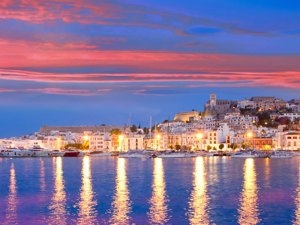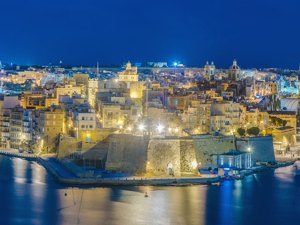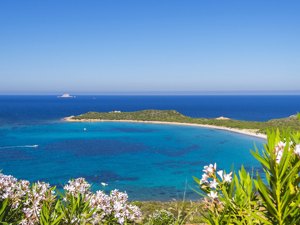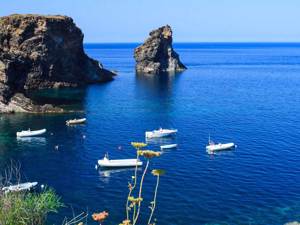A strip of land in front of the Peloponnese
After being subjected to the rule of the Normans, Franks, Venetians and Turks, since 1864 the island of Kefalonia has been part of Greece, together its sister Ionian islands. Kefalonia is a strip of land in front of the Peloponnese, in the midst of a crystal-clear blue sea, with exceptional beaches, mysterious caves, beautiful scenery and a rich cultural heritage dating back to the Mycenaean period, which follows much of the history of Greece.

View of the village of Assos on the island of Cefalonia. Foto: Copyright © Sisterscom.com / Shutterstock
According to mythology, its name derives from the first King Kefalos. The island is characterised by a refined culture, a legacy in part of the Venetians, who ruled for over 300 years. Its name has been in the news and it became a part of recent history during the Second World War because of the resistance of its inhabitants against the forces of the Axis - the Italians and Germans - with events of great valour on both sides. The famous film “Captain Corelli’s Mandolin”, which tells of one of the stories of the resistance during that time, was shot in the natural environments of the island.
Besides its history, Kefalonia offers various attractions, including sports activities, which range from tennis to minigolf and mountain-climbing – given that there are also mountains of a considerable height.

Lighthouse of Saint Theodore in Lassi - Argostoli. Foto: Copyright © Sisterscom.com / Shutterstock
Argostoli
Since 1757 the chief town has been Argostoli, the largest port on the island. A lively, modern town, although steeped in traditions, Argostoli has manyNeoclassical buildings and a spectacular amphitheatre layout, which was used frequently on the Greek islands because it kept light on the facades of the houses. It is also known for its lively cultural activities and has a philharmonic orchestra and numerous theatre companies.
There are endless discoveries to be made while strolling around the town, including the spacious central square dedicated to the benefactor P. Vallianos, astatue of whom is also to be found in the centre: the square is filled with shops, coffee shops and restaurants and very popular; or Napier Garden, which in spite of its small size is filled with a great many trees. The main street Lithostroto, meaning paved street, is filled with shops and meeting spots for young people. In its centre is Kambanas Square, which has a bell tower of the same name and from which a wonderful view over the city and the surrounding Koutavos Lagoon can be enjoyed.

Copyright © Sisterscom.com / Shutterstock
The history of Ancient Greece is illustrated in the Archaeological Museum, which is filled with Mycenaean finds, and the island’s Byzantine story can be discovered in the Korgialenios Library, which has a vast collection of splendid icons.
The churches are dedicated to the Virgin Mary as well as the Saints - in Greek Agios - such as the church of Agios Nikolaos, Aghia Barbara, Agios Spiridos.
Religious tourism is very popular because many of the monasteries offer beds in comfortable dormitories for worshippers. One religious monument that should not be missed is the beautiful Monastery of Agios Gherasimos, patron saint of the island, in honour of which two processions a year take place - on 16 August, day of his death, and on 20 October, day of the translation of his remains. The building is found near to the Valley of ‘Saranta Pigadia’, or forty wells, and is surrounded by vineyards.
The beaches of Lassi
Approximately two kilometres from the chief town is Lassi, a well-known resort with vast sandy beaches that have names such as Makris Gialos and Platis Gialos.

The beaches of Platis Gialos and Makris Gialos near Lassi. Foto: Copyright © Sisterscom.com / Shutterstock
Here are a large number of picturesque villages around Argostoli that are well worth visiting, such as Lakithra, as well as Kourkoumelata, Metaxata, Kaligata and Domata, and Svoronata, which is filled with beautiful Neoclassical houses.
Angostoli Airport is bustling with passengers. Located only 8 kilometres from the city, the airport allows the nearby tourist resorts of Keramies, Metaxata, Monampeles and Sarlata to be reached in rapid time.
Typical products with sea view

Greek salad with feta and white wine. Photo: Copyright © Sisterscom.com / Shutterstock
Feta, the typical Greek cheese, is widely used in local cuisine, but there are also traditional island dishes such as the Kefalonia savoury pies,bourbourelia, a flavoursome soup of beans, and Aliada, boiled octopus with mashed potatoes. The most famous wine of the island is Robola, a perfumed dry white wine, but the sweet white Muscat is also excellent.
Text by Anna Glik
Updated by Alisè Vitri
Video:www.visitgreece.gr
Tourism Board
www.kefalonia.gr
www.visitgreece.gr
Partnership with Booking.com
Where to sleep in Kefalonia

Photo: Copyright © Sisterscom.com / Shutterstock
Kefalonia is a welcoming city and offers different possibilities for accommodation.
To find the ideal hotel and the best offers you can do a search for the stars but also for districts or landmarks.
WHERE TO GO in Kefalonia
Excursions in Kefalonia and surroundings

Copyright © Sisterscom.com / Shutterstock
ARGOSTOLI
It has been the capital town of the island since 1757. Argostoli is a modern town that keeps many of the traditional architectural elements of the past. It has been built in an amphitheatre-like manner, overlooking Koutavos Lagoon, a stopover area for many migratory birds. A large number of Neoclassical buildings, large squares and churches grace the town. There is a remarkable diversity of cultural events as the town’s Philharmonic Band, choirs, and drama groups are quite active.

Copyright © Sisterscom.com / Shutterstock
LAKITHRA
Lakithra, 7 km south of Argostoli, it is a large village surrounded by lovely smaller villages and marvellous sandy beaches. The locals call this entire area Leivatho. The small villages of Kourkoumelata, Metaxata, Kaligata, Domata and Svoronata with magnificent Neoclassical buildings, beautiful squares and a breathtaking sea view.

Copyright © Sisterscom.com / Shutterstock
AINOS NATIONAL RESERVE
Near Valsamata we find the Ainos National Reserve where the trails will take you through lovely forests of fir trees; On Mt. Ainos, one of them is unique in expanse and to a very high degree consists of Abies Cephalonica, the black fir, native to Kefalonia. The Reserve is also a refuge for the small horse breed of the species Equus caballus, living in a semi wild state. Ainos’ tallest peak is Megalos Soros(elevation: 1,628 m).

Copyright © Sisterscom.com / Shutterstock
SAMI
Sami is a seaside town built at the foot of two hills on the Kefalonia island’s east side, on the location of the ancient town of Same. It is Kefalonia’s second largest port and the only one connecting the island to Italy. Dense vegetation covers the surrounding area which is extremely interesting from a geological point of view. Distance from Argostoli: 24 km north-est.

Copyright © Sisterscom.com / Shutterstock
FISKARDO
A well-known cosmopolitan town, Fiskardo, known as Panormos in antiquity, is a listed traditional village with lovely houses (some date back to the 18th century), painted with vivid colours, picturesque narrow alleys, tourist shops, restaurants, fish tavernas, bars, and cafés. From this port, there is a shuttle boat service running to Ithaca and Lefkada; it is also a mooring area for luxury yachts since Fiskardo is on the list of destinations preferred by the International jet set. Distance from Argostoli: 49.5 km north.
Partnership with GetYourGuide
Tours and excursions
You might be interested in
Other destinations
Airports nearby Kefalonia


































